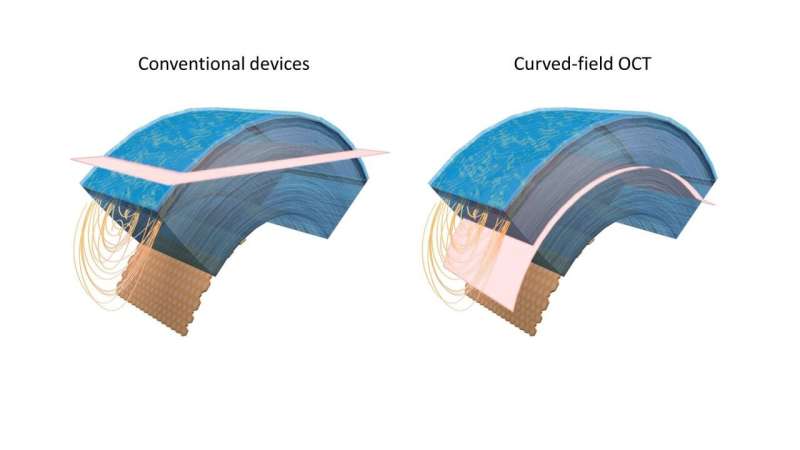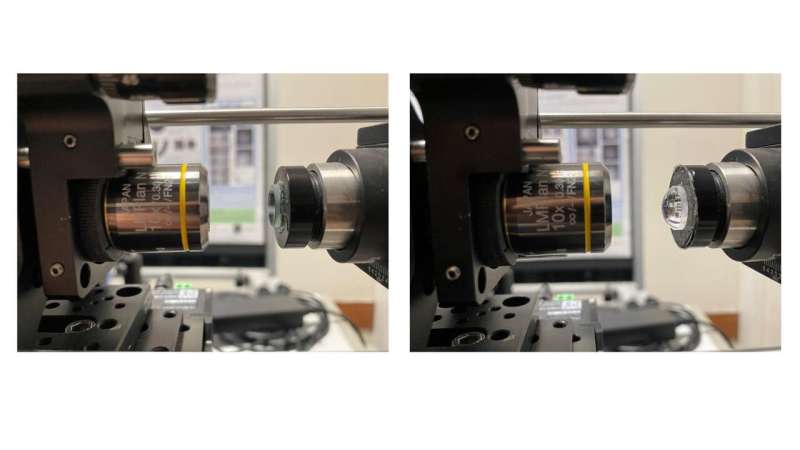Researchers capture cell-level details of curved cornea

Researchers have, for the first time, acquired optical coherence tomography (OCT) images of the curved layers of a person's cornea with cell-level detail and a large viewing area. The new OCT instrument enables improved monitoring of eye diseases as well as general health conditions such as diabetes, which alter the density of nerves in the cornea.
"As the curved outermost part of the eye, the cornea offers a transparent window into both ocular and general health conditions," said corresponding author Viacheslav Mazlin, from The Langevin Institute, a joint research unit between ESPCI Paris and CNRS in France. "The cell-level resolution and large viewing area available from our instrument are ideal for monitoring corneal diseases like endothelial dysfunction and general diabetic conditions, understanding their evolution at the biological scale, and quantitatively evaluating the efficacy of novel treatment strategies."
In Optica, The Optical Society's (OSA) journal for high-impact research, Mazlin and a multi-institutional group of colleagues describe their new curved-field OCT device, which provides high-resolution optical sections with an area ten times larger than clinical devices currently used for corneal diagnostics. The combination of high resolution with large viewing area enables more precise counting of cells and nerves for diagnosing disease and reduces the chance of missing a disease-affected area.
Improving cataract surgery
A high-resolution view with a large imaging area is particularly important for improving the outcomes of cataract surgeries. Cataract surgery causes a loss of endothelial cells, and if the number of those cells drops below a critical threshold value then a person may require a corneal transplant.
"Doctors frequently perform endothelial cell counting before cataract surgery to ensure there will be enough endothelial cells to preserve the cornea after the surgery," said co-author Kristina Irsch from Sorbonne University in France. "Because our instrument provides a much larger viewing area than the existing clinical devices, we can count more cells, making for a more accurate evaluation of the corneal health and potentially improving surgical predictions and outcomes."
The new technique is based on OCT, a high-resolution non-invasive imaging technique that is commonly used to acquire cross-sectional images of the retina. OCT acquires thin optical slices by using interference between the light from the sample and the light from a mirror located in an additional optical reference arm.

The existing full-field OCT approach was developed to acquire optical sections parallel to the surface of the eye. The entire slice is captured by a 2-D camera. However, acquiring a flat slice across a curved sample like the cornea would slice through several corneal layers at once, limiting the field of view.
To capture optical sections that match the curvature of the cornea—in other words, optically flattening the cornea—the researchers used a full-field OCT configuration where the flat mirror in the additional optical reference arm is replaced with a curved optical lens. The 2-D camera captures all the pixels within the viewing area at the same time, making this approach immune to artifacts that can arise with other OCT configurations.
"The ability to use full-field and curved-field OCT to image eyes in people—where the eye is constantly moving—became possible recently, thanks to the development of advanced cameras with higher speeds and better light-detection capabilities," said research team leader Claude Boccara from The Langevin Institute.
Testing the device
After testing the device on a flat target and a model eye, they used it to image the cornea of a healthy person. This required centering the instrument on the corneal apex—the point of maximum curvature—while the eye was moving. They accomplished this by placing the device on a motorized XYZ translation stage that could be moved with a joystick.
With this setup, the alignment took only a few minutes, while image capture was completed in a fraction of a second. The device successfully captured nerve and endothelial cell slices of the person's cornea with an unprecedented viewing area larger than 1 square millimeter.
The new device could also have applications beyond ophthalmology. "Our device is universal and may prove useful for studying any type of transparent sample exhibiting a curved structure," said Mazlin.
The researchers say that the device is ready for use in clinical research. They are working to incorporate features that would improve the experience of clinicians, such as automatic cell counting and easier aligning procedures. They are also planning to increase the viewing area even more with only a slight reduction in resolution.
More information: Viacheslav Mazlin et al, Curved-field optical coherence tomography: large-field imaging of human corneal cells and nerves, Optica (2020). DOI: 10.1364/OPTICA.396949





















